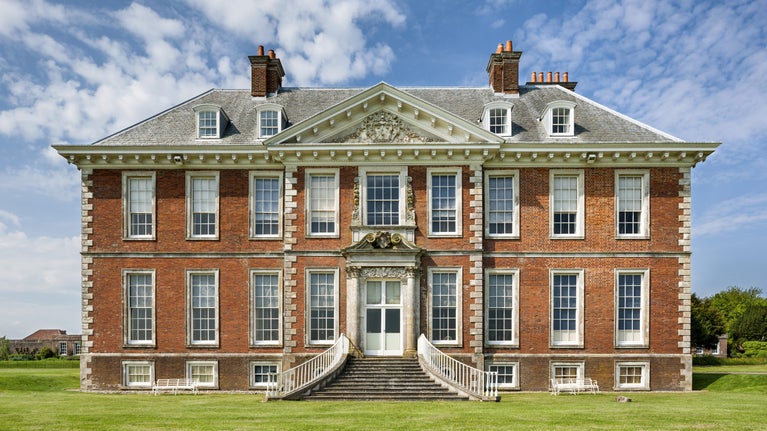
Discover more at Uppark House and Garden
Find out when Uppark House and Garden is open, how to get here, the things to see and do and more.

This article takes you on a whistle-stop tour of the many and varied parts of the mansion at Uppark, decorated with antique furniture, ornaments and paintings. To experience the real thing, book one of our expert guided tours, and get a fascinating insight into 18th-century life in a fine country house for those both above and below stairs.
When famous landscape designer Humphry Repton moved the entrance to the north side and added the portico, the North Corridor was built to link the two structures. While the intricately patterned red baize door draws the eye towards the Staircase Hall, be sure to look up at the stained-glass windows.
The fire of 1989 burnt fiercest here, with only a single newel post and two balusters surviving. The 19th-century Gothic lantern that hangs here was completely flattened as the floors above collapsed, but incredibly it was painstakingly restored to its original form.
Servants carried food from the kitchen using the underground tunnels, and from here it could be served to guests in the next-door Dining Room.
The stained-glass window was designed by Humphry Repton's son, John Adey, and was lit from behind by oil lamps after dark. The scenes below it were inspired by the Elgin Marbles, classical Greek sculptures from the Parthenon that came to Britain in 1807.
Owner Sir Harry Fetherstonhaugh was famous for his parties, with guests including the Prince of Wales and Emma Hamilton, who would later be Lord Nelson's mistress, who is said to have danced naked on the dining table.
The room itself features panelling, pilasters and mirrored niches designed by Humphry Repton, and forms the perfect backdrop for many fine pieces such as the specially commissioned Chinese dinner service.
Originally the day-to-day entrance (hence the stone floor), the Stone Hall is home to an exquisite carved marble fireplace by Thomas Carter, a gilt bronze French lantern that, remarkably, had been crushed in the fire of 1989, and a pair of scagliola tables commissioned by Sir Matthew Fetherstonhaugh in the 1750s.
One of the sunniest rooms in the house, the Little Parlour was popular with the ladies of Uppark, although few signs of it remain. This room was destroyed during the 1989 fire when a falling chimneystack carried it into the basement.
The details on the black japanned 'pagoda' cabinet are particularly worth a closer look, although the Prince of Wales is said to have tied his dog to one of its legs during a visit in the 1780s.
Perhaps the most impressive room in the house, the Saloon was originally the entrance hall. After the fire, the intricate plasterwork ceiling was reassembled from rescued fragments, with the craftsmen and women relearning the skill of freehand lime modelling in order to restore the damaged sections.
The Carter chimneypieces depict the stories of Romulus and Remus, flanked by classical Greek busts, while the finest of Sir Harry's furniture includes a piece by French 17th-century cabinetmaker Andre-Charles Boulle.

Some of the wallpaper in this room dates back to the 1850s, having survived the fire after being torn from the walls in huge strips in a last-ditch rescue bid.
The Axminster carpet dates back to circa 1800 and was badly damaged in the fire, while the gilt-wood pier-glasses were carried out through the windows, in flames. Beneath them sit the stunning Chinese lacquered commodes by Pierre Langlois, circa 1765.
In 1874, this became the dressing room for the adjoining Tapestry bedroom. Look out for the carved marble fireplace depicting the Aesop's fable of the fox and the crane, and the 1752 chinoiserie-style gilt-wood mirror that survived six hours in the fire before being carried out by firemen.
The Prince of Wales probably slept here during the 1780s. His dog is said to have relieved himself on the curtains. The tapestries that give the room its name are early 18th-century Flemish in origin, and show scenes of harvest and winemaking.
They were brought back to Uppark by an anonymous benefactor, having been acquired by an American bank in 1972.

Contrasting with the grandeur and elegance of the first-floor rooms are the servants' quarters in the basement below. At Uppark, these rooms are particularly impressive, and offer a glimpse of a life spent 'below stairs’.
Although the purpose of some rooms may have changed over the 300 years, today they are presented as they would have been in the late 19th century, following the discovery of an inventory of their contents from 1874.
Uppark's grand, 18th-century dolls' house is among the most historically important in the country, and one of only a handful that have survived from the era in such good condition.
Built in the style of a Palladian mansion, the house features three floors topped by a balustrade and seven classical figures, with the Lethieullier coat of arms on the central pediment. It has four bedrooms, two reception rooms and three rooms 'below stairs' for the servants.
The dolls' house is currently on loan at the Huguenot Museum in Kent.

Outside of Christmas at Uppark, happening 7 - 24 December 2025, booking a guided tour is now the only way to visit the house at Uppark. We believe being shown around by an expert will make sure you get the most out of your visit and learn all about the wonderful stories this house has.
Tours take in the ornate rooms used by Uppark's former owners, as well as exploring life below stairs for the people who worked there.
Tours end in the Lower Servant's Hall, which includes a small exhibition looking at items uncovered during the recent repair work and some of the fragments rescued after the fire of 1989.
Tours take place three to four times per day and last for up to 45 minutes, with time at the end to explore the exhibition. Please note, for the benefit of all participants, tours begin promptly at the designated times.
Children are welcome on tours.
Dogs are not permitted into the house, with the exception of assistance dogs.
Booking is not required for Christmas at Uppark.

Find out when Uppark House and Garden is open, how to get here, the things to see and do and more.
The Palladian-style 18th-century dolls’ house at Uppark is one of only a surviving few. Built on a grand scale, it features opulently decorated rooms and beautifully dressed dolls.

Uppark is a fine example of a 17th-century country house, crowning the South Downs ridge in West Sussex. Cherished by generations of families, Uppark has attracted a succession of colourful owners, residents and visitors including the Fetherstonhaugh family, Emma Hamilton and a young H.G. Wells.

Free to visit, these intimate and colourful gardens offer a scented garden, amphitheatre, architectural flourishes and panoramic views across the South Downs.

Find out what family-friendly activities you can enjoy at Uppark House and Garden, from nature trails to theatre events, picnicking to kite-flying.

We look after the largest collection of historic Chinese wallpapers on permanent public display in the world. Learn more about the evolution of paper wallcoverings and the different styles through the centuries.

From the art gallery at Petworth, to a cosy Arts and Crafts home at Standen, you'll be amazed at the variety of houses and unusual buildings to explore in Sussex.
